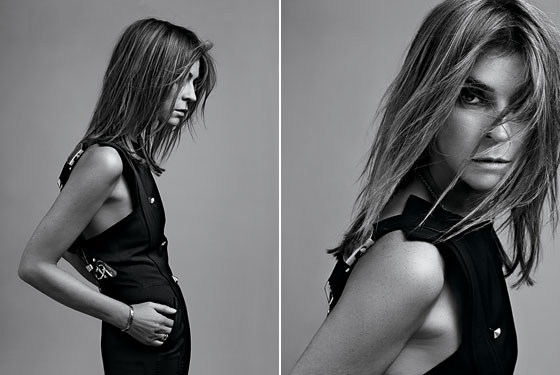 |
(Photo: Hedi Slimane) |
When Carine Roitfeld, the editor of French Vogue, styles a fashion shoot, she does not start with the clothes. She looks first at the model and comes up with a story: Perhaps this girl has married young and taken a lover. Perhaps she married young, has taken three lovers, and is about to go to Brazil. Perhaps she lives in London and is bored to death with mad cow disease and wants desperately to eat a great, juicy piece of steak. “I do a movie in my mind,” she says. “Who is this girl?”
One cold, bright December morning, her own story is this: She is a fiftyish woman having a double espresso in the lobby of the Carlyle on Madison Avenue. “For me, it is best to be the youngest in hotel,” she explains, “and I was not having this feeling at the Mercer.” She has come to New York for her son Vladimir’s 23rd birthday, which she celebrated the night before with dinner at Indochine. “It makes me happy because there is vewy gweat lighting,” she says about the restaurant. “Vewy flatter.” (Roitfeld has reached a compromise with the hard American r by converting them all to ws.)
She was especially pleased with the lighting because of a disfiguring recent visit to the dermatologist. “I am monster,” she explains, gesturing at an infinitesimal dot on her nose.
Roitfeld has slid out of a fluffy paneled Tom Ford fur cape, and it is gathered at her waist, her impossibly skinny body sticking out of each side. Her eyebrows are thick and dark, her hair is surprisingly blonde—“I follow an advice of Tom Ford: When you get older, you have to get blonder. It is my surfer look.”
In the story she comes up with for herself, it is her ambition to look like the subject of a Helmut Newton photograph, and she does, in a way: She sort of exists in black-and-white, and her clothes often bear straps and buckles, a very light fashion bondage. She also looks, as has often been pointed out, quite a lot like Iggy Pop.
But she does not think much about her influences. “Some editors, they have that, they know all the designer from the beginning of the nineteenth century. They know this is triple cashmere, this is simple cashmere. Maybe they went to fashion school. Me, I don’t. I just get a feeling about what is exciting. It is all just from feeling. So I don’t know”—she pulls her lips into a pout and gives one of those poufy little French exhales—“I think maybe I have a talent.”
Roitfeld has been the editor-in-chief of French Vogue for the past seven years, ever since she took over from the cerebral Joan Juliet Buck. Roitfeld remade French Vogue in her own image, which is to say svelte, tough, luxurious, and wholeheartedly in love with dangling-cigarette, bare-chested fashion. French Vogue is now internationally major, to use an industry expression, with an influence that transcends its tiny (133,000) circulation.
So much of the fashion world is about negotiating insecurity—exploiting it enough to make you want to buy things, but still nurturing, to keep you close. But Carine Roitfeld is like the industry’s X factor: Fashion does not, could not, make her insecure. Fashion is the place in the world where Roitfeld is most comfortable and at home.
Because of this, Roitfeld’s French Vogue is the polar opposite of most American fashion magazines. It is unconcerned with making fashion wearable or accessible to its readers. It is not inclusive: There is no advice on how to dress if you’re shaped like a pear or about to turn 50.
In Roitfeld’s world, models are never too skinny, diamonds are never too expensive. Covers are not devoted to whichever film star has a blockbuster to promote, but primarily to models—when Roitfeld and Bruce Weber happened upon (former “Look Book” subject) André J., a black transvestite with an Afro, incredible legs, and an Amish-style chinstrap beard, they put him in a minidress and on the cover.
French Vogue assumes membership in a club that treats fashion unapologetically. Guest editorships are given to cool girls of the moment (Kate Moss, Sofia Coppola, Charlotte Gainsbourg), who post endless photos of themselves and their skinny friends and the details of their lives—lives in which such mundanities as medicine cabinets and grocery lists are shown to be far more glamorous than your own. The scrappy documentary photography of these features only underlines how naturally cool such people are: Their glamour is presented as something that doesn’t need the aid of stylists and special lighting. It is innate.
When French Vogue cover girls aren’t models, they needn’t be typically pretty. Gainsbourg, for example, is somewhat jolie laide, with a long, narrow face and sad eyes. She looks fantastic wearing the Japanese avant-garde, which is not something that can be said for, say, Kate Bosworth.

